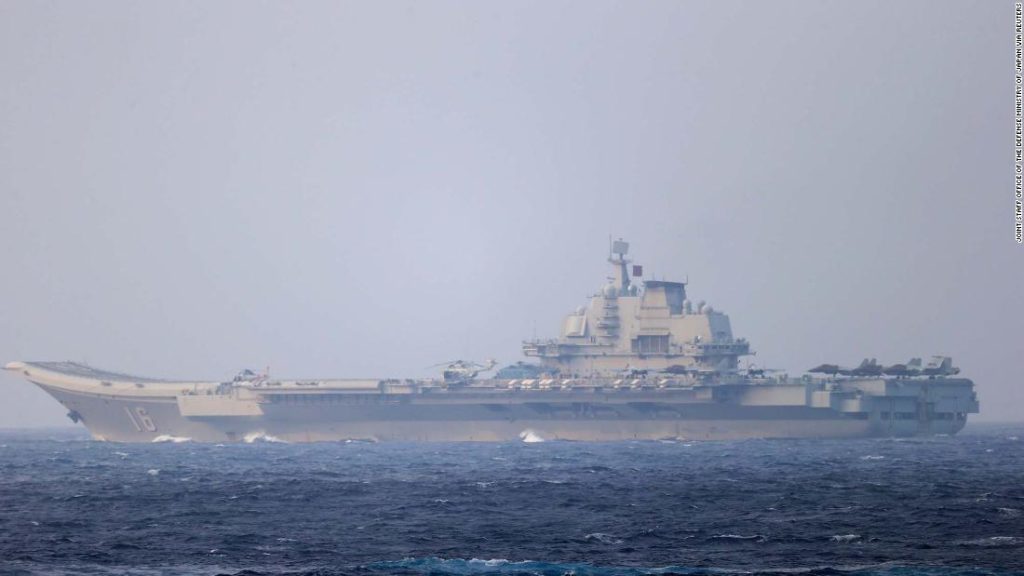The Chinese aircraft carrier Liaoning and its escorts were conducting maneuvers around Taiwan, China’s military said in a statement Monday.
“It was a routine training exercise organized according to the annual work plan to test the troops’ training effectiveness and beef up their capability to safeguard national sovereignty, security and development interests,” the statement said.
Meanwhile, at least 10 People’s Liberation Army warplanes, including four J-16 and four J-10 fighter jets, a Y-8 anti-submarine warfare aircraft and a KJ-500 early warning aircraft, entered Taiwan’s self-declared air defense identification zone (ADIZ), according to Taiwan’s Defense Ministry.
The US Federal Aviation Administration defines an ADIZ as “a designated area of airspace over land or water within which a country requires the immediate and positive identification, location, and air traffic control of aircraft in the interest of the country’s national security.”
Beijing claims full sovereignty over Taiwan, a democracy of almost 24 million people located off the southeastern coast of mainland China, even though the two sides have been governed separately for more than seven decades.
Chinese President Xi Jinping has vowed that Beijing will never allow the island to become formally independent and has refused to rule out the use of force, if necessary, to take the island back.
Tensions over Taiwan have been heating up in recent months as Taipei has garnered support from the US in the form of new military hardware, an agreement between the US and Taiwanese coast guards, and strong statements of support from the administration of US President Joe Biden.
“We are committed to deepening ties with Taiwan,” US State Department spokesperson Ned Price said last week.
“China uses coercion and aggression to systemically erode autonomy in Hong Kong, undercut democracy in Taiwan, abuse human rights in Xinjiang and Tibet, and assert maritime claims in the South China Sea that violate international law,” Blinken said.
“We will push back if necessary when China uses coercion or aggression to get its way.”
A ‘warning’ from Beijing
China’s maneuvers Monday demonstrated its military superiority over Taiwan, Shi Hong, executive chief editor of Chinese magazine Shipborne Weapons, said in a Global Times report.
“The exercise showed that the PLA (People’s Liberation Army) is capable of surrounding the island of Taiwan, isolating its troops and leaving them nowhere to run and no chance to win if circumstances arise,” Shi said.
The exercises also sent a message to both the US and Japan, Shi added. Since any US and Japanese military interventions would likely come from the east, China, by exercising its carrier group there, demonstrated it could cut off that help, Shi said.
Western analysts said China did not demonstrate any new capabilities in Monday’s exercises.
In fact, a Chinese carrier in the open Pacific could play to one of the strengths of the US Navy — its nuclear-powered attack submarines (SSN), said Thomas Shugart, a senior fellow at the Center for a New American Security and former US Navy captain.
“A Chinese carrier operating east of Taiwan is not particularly valuable being used like that, as it could be quite vulnerable operating that far out — in SSN-infested deep water and beyond China’s integrated air defense/SAM umbrella,” Shugart said.
But the Chinese military did make a political statement, analysts said.
“It’s intended as a warning to the Taiwanese and others who Beijing deemed as undermining its interests, not least the Americans,” said Collin Koh, research fellow at the S. Rajaratnam School of International Studies in Singapore.
Koh points out that a PLA Navy carrier group has operated east of Taiwan at least twice before.
Such Chinese activity is expected to continue. The PLA said in its statement that carrier operations such as the one staged Monday would occur on a regular basis.
US carrier operates in South China Sea
While the Chinese carrier was conducting exercises off Taiwan, a US Navy aircraft carrier strike group was carrying out its own operations in the South China Sea.
“It is great to be back in the South China Sea to reassure our allies and partners that we remain committed to freedom of the seas,” Rear Adm. Doug Verissimo, commander, Carrier Strike Group Nine, said in a statement.
“While in the South China Sea, the strike group will conduct fixed and rotary-wing flight operations, maritime strike exercises, anti-submarine operations, coordinated tactical training, and more,” the 7th Fleet statement said.
Beijing claims almost all of the 1.3 million square mile South China Sea as its sovereign territory and in recent years has built up military fortifications on several islands.
It says the presence of foreign military forces like the US aircraft carrier strike group are fomenting tensions in the region.
You may also like
-
Afghanistan: Civilian casualties hit record high amid US withdrawal, UN says
-
How Taiwan is trying to defend against a cyber ‘World War III’
-
Pandemic travel news this week: Quarantine escapes and airplane disguises
-
Why would anyone trust Brexit Britain again?
-
Black fungus: A second crisis is killing survivors of India’s worst Covid wave

